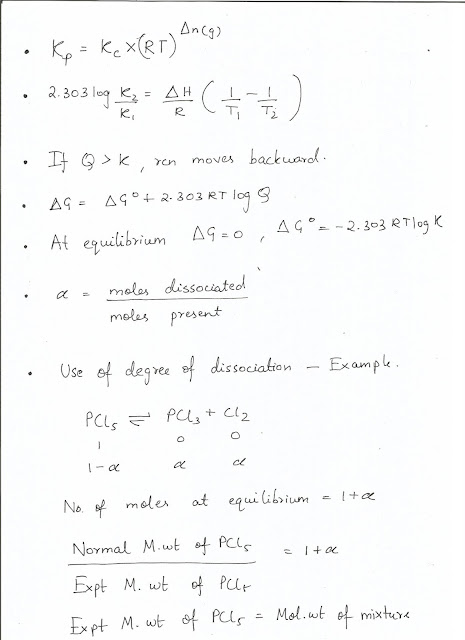Monday, July 18, 2016
Thursday, July 14, 2016
IONIC EQUILIBRIUM
Ionic equilibrium is the last physical chemistry chapter in class
11. Questions from this chapter are generally straightforward.
However, there are several different types of questions that
can be asked. These models will be covered in detail.
Ionic equilibrium is the last physical chemistry chapter in class
11. Questions from this chapter are generally straightforward.
However, there are several different types of questions that
can be asked. These models will be covered in detail.
IMPORTANT EXAMPLES :
These were the important points in ionic equilibrium. With this,
physical chemistry of class 11 comes to an end.
THANK YOU
Thursday, July 7, 2016
PERIODIC PROPERTIES
Periodic Properties is an important chapter in jee mains but is not
part of jee advanced syllabus. However , it plays an important
role in understanding inorganic chemistry .In this post , i will
be covering the important points in periodic properties.
NOTES:
Ionisation Energy :
1. It is the minimum amount of energy required to remove an
electron from the valence shell of an isolated gaseous atom.
2. The removal of the 2nd electron is naturally more difficult than
the first. Therefore for any element , IE 3 > IE 2 > IE 1 .
3. Factors which effect ionisation energy :
a) Effective nuclear charge -
The magnitude of effective nuclear charge increases along
the period.
The magnitude of effective nuclear charge decreases
slightly down the group.
b) Size of the atom :
Size increases down the group. As a result , the ionisation
energy decreases.
c) Orbital involved :
Ease of removal : s < p < d< f
eg. Let us compare the IE of K and Cu. The first ionisation
energy of copper is more ( this is due to smaller size )
However , the second ionisation energy of copper is
smaller than potassium because the electron is removed
from the d orbital
d) Nature of Configuration :
Fully filled and Half filled orbitals have greater IE.
NOTE : IE for transition metals increases along the period and
then becomes constant.
ELECTRON AFFINITY:
1. It is the amount of energy released when an electron is added
to the outermost shell of a neutral gaseous atom.
2. For second electron affinity and beyond we need to supply
energy.
3. Factors which influence electron affinity:
a) Effective nuclear charge - Generally , greater the
effective nuclear charge , greater the electron affinity.
b) Size of the atom.
c) Electronic configuration: Half filled and fully filled
orbitals have low electron affinity.
ELECTRONEGATIVITY :
a) Effective nuclear charge - Generally , greater the
effective nuclear charge , greater the electron affinity.
b) Size of the atom.
c) Electronic configuration: Half filled and fully filled
orbitals have low electron affinity.
ELECTRONEGATIVITY :
Monday, July 4, 2016
CHEMICAL EQUILIBRIUM
Equilibrium is the next topic in physical chemistry and consists
of both chemical and ionic equilibrium. Questions in this
chapter are generally easy in iit jee but most students find
ionic equilibrium challenging. I hope to cover all models of
problems on both these chapters.
Chemical Equilibrium:
Le Chatelier 's principle :
1. Increase in concentration of reactants moves the reaction
forward. ( not for solids)
2. Increase in pressure moves in direction of lesser no of moles
of gas.
3. Addition of inert gas at constant volume - No change.
4. Addition of inert gas at constant pressure moves the reaction
in direction of greater number of moles.
5. In the ice water equilibrium, melting point decreases with
increase in pressure.
6. With increase in temperature , equilibrium constant of an
endothermic reaction increases. The opposite is true for
an exothermic reaction.
NOTE: Solubility of NaOH increases with temperature
although dissolution is an exothermic process.
THANK YOU
Subscribe to:
Comments (Atom)



































